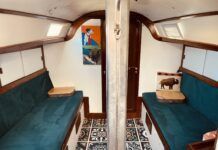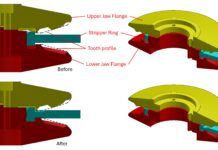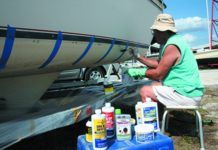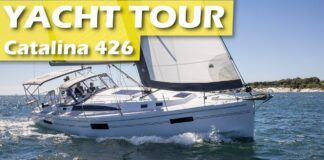I enjoyed your article on the Catalina 34 (see PS March 2015 online). I have owned a 1991 Mk1.5 (sn 1120), and currently own a 1988 Mk1 (sn 728), so I clearly am a fan of the boat. Just a few other bits of information for you, and some clarifications and corrections. As the technical editor of the Catalina 34 Association International, I have perhaps more historical resources at my disposal than most, including ready access to the talented designer of the boat, Gerry Douglas at Catalina.
Based upon Catalina records, the Mk1 and later the Mk1.5 boats were built between 1986 and 1994 with serial numbers 1 through 1294. The Mk2 boats were built between 1995 and 2008 with serial numbers 1295 through 1802. The 1986 model had a 21-horsepower M25 Universal diesel engine; the 1987 to 1992 boats had the 23-horsepower M25XP Universal engine, with an optional 30-horsepower M35 for the 1990 to 1994 models. All of the Mk2 boats had the 35-horespower M35BC Universal engine. The year associated with the production of the boats made during the pre-Mk2 design and the Mk2 design can vary during the transition period, depending on which data source you use because there is some overlap between the boat manufacturing date versus the assigned model year of the boat. However, the cited data from Catalina is stated in terms of model-year assignment. The last boat produced, hull number 1802, was a 2008 model that was also manufactured in 2008.
Our 1991 boat had the optional 30-horsepower engine, and the added power was very nice when motoring into a strong wind. I agree that the 21- and 23-horsepower engines always seemed just marginal in such situations.
As an interesting aside, the C34 is such a popular boat that there have many, many upgrades added by owners of the pre-Mk2 boats. Most of these boats have at least some electrical upgrades: a badly needed engine control harness replacement; increased battery capacity compared to the original two-battery configuration; and often a corresponding alternator capacity upgrade, which often included an upgraded alternator voltage regulator linked to a remote smart control. Wheel-driven autopilots are also very common, along with GPS additions in various forms. I would say that the typical pre-Mk2 boat likely has several useful modifications and improvements already in place.
On my own boat, I have probably gone a bit overboard on modifications. I designed and performed an installation of a NextGen 3.5-kilowatt diesel genset in the aft lazarette. This required additional modifications to steering quadrant configuration, but it was all accomplished with off-the-shelf parts from Edson and a little ingenuity. I didnt have to relocate the propane storage because some of the 1980s boats had what I believe was an optional CNG tank system mounted under the small seat in the aft stateroom rather than the aft propane storage locker. I have the CNG system on my boat. Here in the north-central Texas summers, it makes overnight stays on the water an enjoyable experience. My experience with the little genset has been spectacular, including excellent support from the manufacturer. I would highly recommend it to anyone.
The aft head, as you noted, is very handy. It also was the first aft head design on a production sailboat in the U.S., something Douglas is proud to have included as a design feature.
John Nixon
Otra Vez, Catalina 34, hull no. 728
Texas

In regard to the March 2015 boat review of the Catalina 34: I can confirm what was stated about the weather helm on the boat and the need to take an early reef in the main. That is improved with the elliptical rudder, but an even bigger improvement is a 135 headsail compared to a 150. The overlapping part of the headsail is behind the center of lateral resistance and contributes to weather helm. A flatter headsail also helps prevent the boat from rounding up. But she is a fine cruising boat with strong, simple systems that last and last.And the support from both the owners association and Catalina Yachts is second to none.
Clay Greene
Cattywampus, Catalina 387 former owner Serendipity, Catalina 34
Milwaukee, Wis.
With the cost of bottom paint going higher and higher, what does PS think of alternating the paint coat formulas within the same manufacturer family? For example, (using PS 2014 recommendations), the first coat would be with Blue Water Copper Shield 45 Hard and the second coat would be with Blue Water Copper Pro SCX 67 Hard. In this example, the boat owner would save $120 compared to doing both coats with the SCX 67, and Im wondering if it would make a significant difference in performance.
Mike Hirko
Destiny, Tayana Vancouver 42
Gig Harbor, Wash.
We took your question to Blue Water Paints Don Schnurr, who explained that while it is feasible to save money by alternating compatible paints with each coat, youll also be alternating effectiveness. An antifouling paints performance is based on the amount of biocide that can be released and the paints polishing rate. For modified hard epoxies like the two you mentioned, it is primarily the amount of biocide and not the polishing rate that determine performance. So, you would effectively be layering 67-percent copper over 45-percent copper; once that top coat is worn through, youll have less antifouling ability. Schnurr instead suggested applying three coats of the Copper Shield 45 Hard (45 percent copper), so that you would have more biocide to release, but that may not end up saving as much money during application. In the long run, this also may mean more frequent cleanings, haulouts, and re-painting, which of course, cost money.
In regard to your March 2014 article on favorite antifouling paints by region: Your assumption that New Englanders who use expensive bottom paints do not re-paint every year is not correct. I live in the Boston area, and for over 50 years of boating/sailing, I havent known a single person who does not re-paint each year, no matter how expensive the materials are priced or how it might have held up the previous year.
My boat is located in an inlet with fairly high current (1 to 1.7 knots), and the expensive ablatives that Ive used tend to hold up against growth until mid to late August. Then, its cleaning every three weeks or so-more often if you are inclined to race. Even in lower-current areas, I see lots of dirty bottoms toward mid-August.
Ive found that the higher the copper content in my bottom paint, the better my bottom looks. Im doing an experiment this year. I purchased finely ground copper and will be mixing it into the paint that I apply onto my keel, since I don’t relish diving down there anymore. The rest of the hull, I can easily reach with a long-handled soft brush. The advance of biological ingredients revises a question as to which is more harmful, weird biology/chemistry or more copper (a naturally occurring element), but I might try that on part of my hull as well.
Ed White
Caliente, Cal 35
Hull, Mass.
Heres our take: For the best value in areas with short seasons, apply two coats of the cheapest ablative paint that works in your area and paint every year. To reduce the time spent painting, you can apply at least three coats of a top-shelf, re-launchable, multi-season paint (preferably ablative) and paint every other year. We took this approach in Rhode Island and got satisfactory results for years. In many areas, using a top-shelf, multi-season paint for just five months of protection is not cost effective, but it sounds like youve got some very fertile waters. We hope your experience with ground copper is better than ours has been.
Regarding your December 2014 article on installing an SSB: Crimp-on coax connectors are the way to go! Soldering the connectors demands large amounts of heat, and this heat can damage the RF characteristics of the coaxial cable you are soldering to. Should this occur, it will negatively impact overall system performance, particularly during transmit. Stay away from twist-on connectors. Crimp connectors actually result in a hermetic seal between the connector and the coaxial elements of the cable. As well, a solder connector creates stiff points in the usually flexible coax, which are more likely to break in the high vibration environment aboard boats.
Mitchell Sisak
Via email
We soldered on the PL-259 connectors ourselves, but as you noted, this project is easy to mess up and is not for the novice. The dielectric of the coax cable can be deformed by excessive heat, and in a worst-case scenario, this can affect the coaxs transmission properties.
Soldering is not ideal for all connections, because it can create a stiff point that is more susceptible to breakage due to vibration; thats why butt connectors with heat shrink ends are preferred for wire-to-wire connections. But the same argument could be made for crimp-on connectors; the area with the connector crimps to the wire, creating a stiff area on the normally flexible cable. Regardless, if the coax is properly supported and secured against excessive movement, it will not put stress on the connector or allow it to work due to vibration, greatly reducing or eliminating the potential for breaking the solder joint. Unless you are a proficient solderer, we recommend having the connections made by a professional, purchasing prefabricated cables of the correct length, or using crimp-on coax connectors.

In regard to the recent foul-weather gear reviews (mens in February 2015 issue and womens in the March 2015 issue): Women have a very hard time finding good-quality gear that actually fits a womans body and isn’t just downsized from mens designs.
I own the West Marine Third Reef jacket and find it to be of great quality and functionality, working well when we do any coastal or short offshore sailing (several islands off Massachusetts and Rhode Island). I don’t think it was a fair statement for the writer of the mens foulie review to say that the Third Reef is best suited to the cash-strapped sailor, since that is not the case! My buying it was a conscious choice. Helly Hansen may be great, but its designs don’t always work for broad-shouldered men or women.
Susan Hartman
Kismet, Sabre 28





































